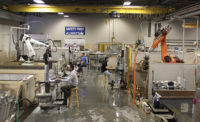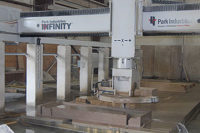It wasn't just something that people talked about, but rather it seemed to be a company culture. Everywhere I went, there was an emphasis on these points, and it was evident in all phases of production -- from quarrying and processing to packaging and transportation. Let's face it, the English are known for being fastidious (and I mean that in a good way here), and this clearly translates to the stoneworking operations that I saw. Burlington Stone even has a dedicated staff member with the title of "Health & Safety/Quality Manager," an ex-military professional who is now making this his life's work. Moreover, this philosophy has clearly been shared across all facets of the company.
My main point here is that it was great to see a stoneworking company that is not only able to balance its quality, safety and efficiency in a practical way, but has also gotten all of its employees on board to create an overall culture in all phases of the day-to-day operations. It provides excellent examples that can be followed at stoneworking operations of all sizes and demographics. At a time when our industry is developing its International Product Standard for Dimensional Stone (see our "Industry Issue of the Month" below), a lot of these points are fresh in my mind, so it was great to see these activities taking place in practice in an area I had never visited before.
(Editor's note: Since I was all decked out in my safety gear during my tour of the roofing plant, my hosts couldn't resist giving me a chance to split a piece of stone on my own (pictured at the top of this article). It took me two full minutes, during which I completely destroyed one workpiece, but I finally succeeded in my mission. For comparison's sake, I watched one of the professionals do it, and he could easily split about 10 pieces in that same amount of time. I asked the manger how long it takes to learn this unique skill, and he said it generally takes three years. Then he smiled and added, "Of course, I've been here 22 years, and I still break them sometimes.")


